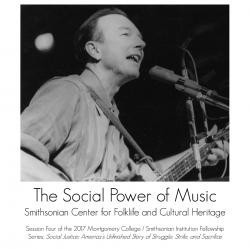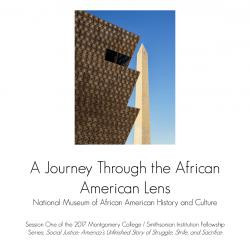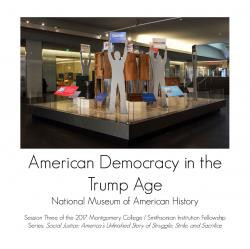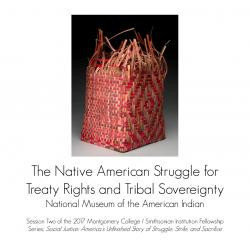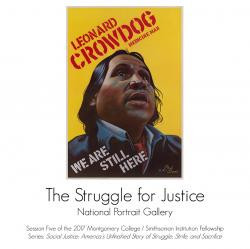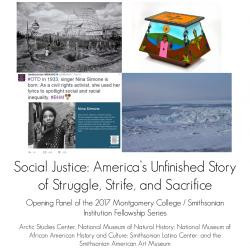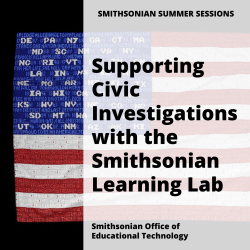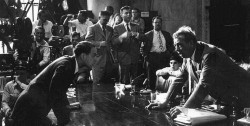Tess Porter
User Experience Strategist (she/her)
Smithsonian Office of Educational Technology
I'm the former User Experience Strategist at the Smithsonian Office of Educational Technology. Here, I focused on the use of digital museum resources to support teaching and learning. My work draws on my experience as a museum educator, digital analyst, usability researcher, and content designer. I hold a B.A. in Anthropology and a B.A. in Art History from University Colorado Boulder, and an M.S. in Museums and Digital Culture with an Advanced Certificate in User Experience from Pratt Institute.
Tess Porter's collections
Selena: Examining Portraiture
<p>This teacher's guide provides portraits and analysis questions to enrich students' examination of Selena Quintanilla-Pérez, an American singer known as the "queen of Tejano music." Includes the video "Defining Portraiture: How are portraits both fact and fiction?" and the National Portrait Gallery's "<em>Reading" Portraiture Guide for Educators, </em>both of which provide suggestions and questions for analyzing portraiture. Also includes videos of educators and curators talking about her life and accomplishments, as well as an outfit she wore during performances.</p>
<p>Consider:</p>
<ul><li>What do these portraits have in common? How are they different?</li><li>How are these portraits both fact and fiction?</li><li>How do these portraits reflect how she wanted to be seen, or how others wanted her to be seen? Consider for what purpose these portraits were created.</li><li>Having listened to her music, does the portrait capture your image of Selena? Why, or why not?</li><li>If you were creating your own portrait of Selena, what characteristics would you emphasize, and why?</li></ul><p>Keywords: singer, musician, texas, model, fashion designer, entertainer, #BecauseOfHerStory, #SmithsonianMusic</p>
 Tess Porter
Tess Porter
8
Shoes: Exploring Culture, History, Place, and Innovation
<p>Teacher's guide for using shoes to explore culture, history, place, and innovation. Includes images of thirty shoes and three different strategies, located at the end of the collection, for using these objects in the classroom. </p>
<p>Strategies include: a small-group object analysis activity; a poster, "If You Walked in My Shoes," introducing students to basic primary source analysis questions through six pairs of shoes; and a vocabulary exercise for ESL learners.</p>
 Tess Porter
Tess Porter
33
Slow Looking: Untitled, by El Anatsui
<p>In this collection, students will explore an artwork by El Anatsui, a contemporary artist whose recent work addresses global ideas about the environment, consumerism, and the social history and memory of the "stuff" of our lives. After looking closely and exploring the artwork using an adapted version of Project Zero's "Parts, Purposes, and Complexities" routine, students will create a "diamante" poem using their observations of the artwork and knowledge they gained about El Anatsui's artistic influences. Additional resources about El Anatsui, how to look at African Art, and Project Zero Thinking Routines are located at the end of the collection.</p>
<p><em>This collection was created for the "Smithsonian Learning Lab, Focus on Global Arts and Humanities" session at the 2019 New Jersey Principals and Supervisors Association (NJPSA) Arts Integration Leadership Institute. </em></p>
<p>Keywords: nigeria, african art, textile, poetry, creative writing, analysis</p>
 Tess Porter
Tess Porter
20
Social Justice: National Museum of the American Indian Resources
<p>This collection previews the second seminar of the 2017 Montgomery College / Smithsonian Institution Fellowship seminar series, <em>The Native American Struggle for Treaty Rights and Tribal Sovereignty.</em> Three National Museum of the American Indian staff members will lead this event: Mark Hirsch, David Penney, and Colleen Call Smith.</p>
<p>Resources included in this collection have been chosen by the presenters for participants to explore before the seminar itself.</p>
<p>#MCteach</p>
 Tess Porter
Tess Porter
7
Social Justice: National Portrait Gallery Resources
<p>This collection previews the fifth and final seminar of the 2017 Montgomery College / Smithsonian Institution Fellowship seminar series, <em>The Struggle for Justice</em>. Two National Portrait Gallery staff members will lead this event: David Ward and Briana Zavadil White.</p>
<p>Resources and questions included in this collection have been chosen by the presenters for participants to explore and consider before the seminar itself. </p>
<p>#MCteach</p>
 Tess Porter
Tess Porter
24
Social Justice: Opening Panel Resources
<p>This collection previews the opening panel of the 2017 Montgomery College / Smithsonian Institution Fellowship seminar series, <em>Social Justice: America's Unfinished Story of Struggle, Strife, and Sacrifice</em>. Four Smithsonian staff members will speak at this event: Igor Krupnik (Arctic Studies Center, Department of Anthropology, National Museum of Natural History), Lanae Spruce (National Museum of African American History and Culture), Ranald Woodaman (Smithsonian Latino Center), and E. Carmen Ramos (Smithsonian American Art Museum).</p>
<p>Each text annotation in this collection contains each speaker's presentation title, description, and bio. Following each text annotation are resources and questions chosen by the presenters for participants to consider before the panel itself.</p>
<p>#MCteach<br /></p>
 Tess Porter
Tess Porter
17
Tennessee Williams: Examining Portraiture
<p>This teacher's guide provides portraits and analysis questions to enrich students' examination of Tennessee Williams, an American playwright and Pulitzer Prize winner. Includes the video "Defining Portraiture: How are portraits both fact and fiction?" and the National Portrait Gallery's "<em>Reading" Portraiture Guide for Educators, </em>both of which provide suggestions and questions for analyzing portraiture. </p>
<p>Consider:</p>
<p></p>
<p></p>
<ul><li>What do these portraits have in common? How are they different?</li><li>How are these portraits both fact and fiction?</li><li>How do these portraits reflect how they wanted to be seen, or how others wanted them to be seen? Consider for what purpose these portraits were created (such as Time Magazine, stamp, etc.).</li><li>Having read one of his plays, does the portrait capture your image of Tennessee Williams? Why, or why not?</li><li>If you were creating your own portrait of Tennessee Williams, what characteristics would you emphasize, and why?</li></ul>
<p></p>
<p></p>
<p>Keywords: mississippi, ms, play, author, streetcar named desire, writer</p>
 Tess Porter
Tess Porter
7
The Bikini Atoll and Operation Crossroads: Unveiling Stories
<p>In this activity, students will analyze photographs documenting the exodus of Bikini islanders from Bikini Atoll prior to Operation Crossroads, a pair of nuclear weapons tests and the first detonations of nuclear devices since the bombing of Nagasaki. These photographs were taken by Carl Mydans and were published in the LIFE Magazine article, "Atomic Bomb Island," on March 25, 1946. </p>
<p>Using two Project Zero Global Thinking Routines - "Unveiling Stories" and "The 3 Ys" - students will analyze the stories these photographs communicate about the experiences of the Bikini islanders and America's perspective on military advancement after WWII. They will also consider the perspectives presented by these photographs, in multiple contexts from the personal to the global. Additional resources (primary sources and the original article) and information on using this collection in the classroom can by found by clicking <em>Read More ».</em></p>
<p>Keywords: atomic testing, atomic bomb, operation crossroads, bikini islands, bikini atoll, rongerik, able test, baker test, nuclear bomb, photojournalism, inquiry strategy, global competence, global competency, 1940s, 40s, 1950s, 50s, 1960s, 60s
</p>
<p><br /></p>
 Tess Porter
Tess Porter
17
The Classical Origin of Iconic American Symbols
<p>In this student activity, analyze how and why iconic symbols of America, such as the Capitol Building and the United States Seal, were inspired by Greek and Roman art and architecture. </p>
<p>Explores the big ideas:</p>
<p></p>
<ul><li>How were symbols of America influenced by those of Ancient Greece and Rome? </li><li>What might this desire to associate America with historic, successful democracies say about early American hopes for their new nation?</li></ul><p></p>
<p>Includes: architecture, a seal, portraiture, a video, a primary source letter, discussion questions, and an opportunity to learn more through the full digitized text of "The Ruins of Palmyra," a publication that heavily inspired early American neoclassical architecture.</p>
<p>Keywords: greece, symbolism, classic, classical</p>
 Tess Porter
Tess Porter
12
Walt Whitman: Examining Portraiture
<p>This teacher's guide provides portraits and analysis questions to enrich students' examination of Walt Whitman, an American poet, essayist, and journalist. Includes the video "Defining Portraiture: How are portraits both fact and fiction?" and the National Portrait Gallery's "<em>Reading" Portraiture Guide for Educators, </em>both of which provide suggestions and questions for analyzing portraiture. Also includes "A Close, Intimate Look at Walt Whitman," an article about the final portrait in this collection that may be used as a lesson extension.</p>
<p>Consider:</p>
<ul><li>What do these portraits have in common? How are they different?</li><li>How are these portraits both fact and fiction?</li><li>How do these portraits reflect how he wanted to be seen, or how others wanted him to be seen? Consider for what purpose these portraits were created.</li><li>Having read one of his poems, does the portrait capture your image of Walt Whitman? Why, or why not?</li><li>If you were creating your own portrait of Walt Whitman, what characteristics would you emphasize, and why?</li></ul><p>Keywords: new york, ny, leaves of grass, humanist, writer</p>
 Tess Porter
Tess Porter
9
What Makes You Say That?: Civil War Photograph
<p>Using the Project Zero Visible Thinking routine "What makes you say that?," students will investigate a photograph from the Civil War taken by the studio of Mathew Brady, one of the most prominent American photographers of the 19th century. The Civil War was the first major war captured on camera and photographs, like this one, played a pivotal role in shaping public perceptions of the conflict.</p>
<p>This activity can be used as an entry point into studying soldiers' experiences during the Civil War, photography's effect on public perspectives about war, and more. Resources to extend this activity include: a Smithsonian American Art Museum lesson plan investigating this and other photographs from the Civil War, a blog post discussing connections between Civil War photography and President Abraham Lincoln, a Smithsonian Magazine article about Civil War photographer Alexander Gardner, a Learning Lab collection on Alexander Gardner's <em>Photographic Sketchbook of the War, </em>and an article discussing the National Portrait Gallery's recent exhibition <em>The Face of Battle: Americans at War, 9/11 to Now</em>.</p>
<p><em>Keywords: photo, battlefield, inquiry strategy</em></p>
 Tess Porter
Tess Porter
8
William Faulkner: Examining Portraiture
<p>This teacher's guide provides portraits and analysis questions to enrich students' examination of William Faulkner, an American author and Nobel Prize laureate. Includes the video "Defining Portraiture: How are portraits both fact and fiction?" and the National Portrait Gallery's "<em>Reading" Portraiture Guide for Educators, </em>both of which provide suggestions and questions for analyzing portraiture. </p>
<p>Consider:</p>
<ul><li>What do these portraits have in common? How are they different?</li><li>How are these portraits both fact and fiction?</li><li>How do these portraits reflect how they wanted to be seen, or how others wanted them to be seen? Consider for what purpose these portraits were created (such as the caricature, stamp, etc.).</li><li>Having read one of his stories, does the portrait capture your image of William Faulkner? Why, or why not?</li><li>If you were creating your own portrait of William Faulkner, what characteristics would you emphasize, and why?</li></ul><p>Keywords: mississippi, ms, the sound and the fury, writer</p>
 Tess Porter
Tess Porter
6

